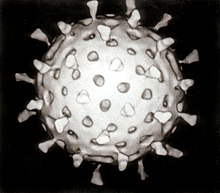Rotavirus
| Rotavirus | |
|---|---|
 |
|
| Computer–aided reconstruction of a rotavirus based on several electron micrographs | |
| Virus classification | |
| Group: | Group III (dsRNA) |
| Order: | Unassigned |
| Family: | Reoviridae |
| Subfamily: | Sedoreovirinae |
| Genus: | Rotavirus |
| Type species | |
|
Rotavirus A |
|
| Species | |
|
|
| Rotaviral Gastroenteritis | |
|---|---|
| Classification and external resources | |
| Specialty | infectious disease |
| ICD-10 | A08.0 |
| ICD-9-CM | 008.61 |
| DiseasesDB | 11667 |
| MedlinePlus | 000252 |
| eMedicine | emerg/401 |
| MeSH | D012400 |
Rotavirus is the most common cause of diarrhoeal disease among infants and young children. It is a genus of double-stranded RNA viruses in the family Reoviridae. Nearly every child in the world is infected with rotavirus at least once by the age of five.Immunity develops with each infection, so subsequent infections are less severe; adults are rarely affected. There are eight species of this virus, referred to as A, B, C, D, E, F, G and H. Rotavirus A, the most common species, causes more than 90% of rotavirus infections in humans.
The virus is transmitted by the faecal-oral route. It infects and damages the cells that line the small intestine and causes gastroenteritis (which is often called "stomach flu" despite having no relation to influenza). Although rotavirus was discovered in 1973 by Ruth Bishop and her colleagues by electron micrograph images and accounts for approximately one third of hospitalisations for severe diarrhoea in infants and children, its importance has historically been underestimated within the public health community, particularly in developing countries. In addition to its impact on human health, rotavirus also infects animals, and is a pathogen of livestock.
Rotavirus is usually an easily managed disease of childhood, but in 2013, rotavirus caused 37 percent of deaths of children from diarrhoea and 215,000 deaths worldwide, and almost two million more become severely ill. Most of these deaths occurred in developing countries. In the United States, before initiation of the rotavirus vaccination programme, rotavirus caused about 2.7 million cases of severe gastroenteritis in children, almost 60,000 hospitalisations, and around 37 deaths each year. Following rotavirus vaccine introduction in the United States, hospitalisation rates have fallen significantly. Public health campaigns to combat rotavirus focus on providing oral rehydration therapy for infected children and vaccination to prevent the disease. The incidence and severity of rotavirus infections has declined significantly in countries that have added rotavirus vaccine to their routine childhood immunisation policies.
...
Wikipedia
